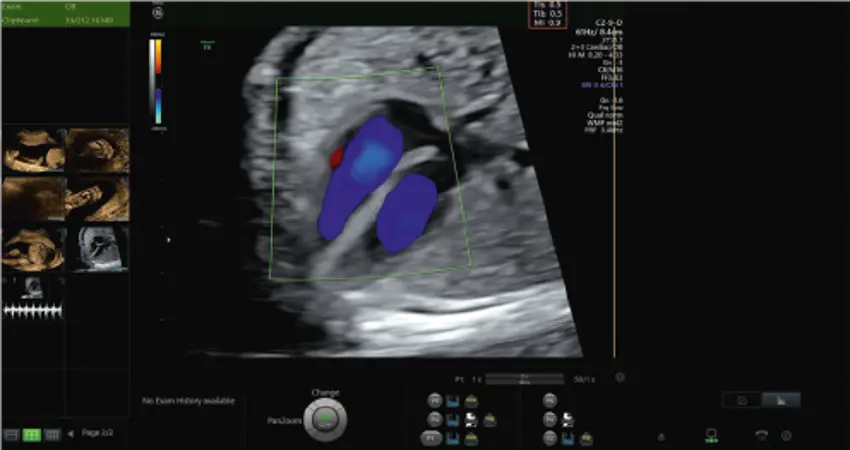14 May 2020
Paper on safety of ultrasound scans gains recognition
Prestigious publication, the European Journal of Ultrasound, picks recent paper as Editor’s choice.

A frame recorded during a routine ultrasound scan. The safety markers are displayed in the top-right of the ultrasound image.
A paper by an inter-disciplinary team of researchers from the Institute of Biomedical Engineering and the Nuffield Department of Women’s & Reproductive Health, published in September 2019, has gained recognition by the European Journal of Ultrasound. The journal has selected the paper, which studies the safety of ultrasound when scanning pregnant women, as Editor’s Choice, with a dedicated editorial piece written around it.
The study uses automated analysis on videos of ultrasound scans where eye-tracking data on the operator of the ultrasound was recorded. This is a huge improvement on previous studies where still images and short loops are mainly used instead of video, and this is the only study to have video information for all stages of pregnancy. They were able to look at how often sonographers and doctors checked safety measures such as the Thermal Index (TI) Value during 637 ultrasound scans in the first, second and third trimesters of pregnancy. The TI Value gives an estimate of the risk, from thermal load, associated with the ultrasound beam – if the TI value is kept under a set limit, then ultrasound can be used for a longer period. If TI limit values are surpassed, examination time must decrease.
Although they found that recommended exposure times were maintained in all scans, eye-tracking analysis suggested safety indicators were checked by the operators in only 4.2% of the scans. This may be due to insufficient training, or a reliance on the safety of the machines. The editorial suggests “Every ultrasound examiner needs to know which technical parameters can be changed and how”.
Co-lead author and Engineering Science DPhil student Richard Droste says, "Ensuring the safety of the mother and fetus is critical for obstetric ultrasound scanning. These scans detect abnormalities and growth restrictions that occur only in a small minority of pregnancies, so 'do no harm' is the guiding principle. In practice, different scanner settings emit different amounts of thermal energy and it is the sonographer's responsibility to stay within certain limits. In our study, we checked the adherence to the guidelines by recording hundreds of routine ultrasound scans and extracting the emitted energy for each of the millions of video frames.”
“This analysis is unprecedented in terms of scale and completeness. In addition, we tracked the sonographers' eye-movements and detected whether they were paying attention to the safety indices. No one had studied this 'safety awareness' previously and it provided new insights that can be used to improve sonographer training."
That all safety protocols were maintained despite the lack of the operator checking the markers is reassuring, though could have the potential to influence the future of ultrasound. If reliance on the safety of machines is a cause then manufacturers may hold a responsibility to put restrictions in place on scanners, the editorial suggests. Additionally, it is important to continue to ensure that trained professionals operate the machinery, especially at early stages in pregnancy.
Co-author and Technikos Professor of Biomedical Engineering Alison Noble FRS FREng remarks, “The reported study is part of a European Research Council (ERC) funded inter-disciplinary project called PULSE which is looking very broadly at how technical advances in deep learning combined with multi-modal imaging can offer new insight into real-world clinical sonography and the development of assistive AI-based technologies to support sonographers in their everyday work. We are delighted that our research on safety indices of ultrasound has been recognised as contributing to the important topic of safety in ultrasound.”
The research is co-authored by Richard Droste, Pierre Chatelain and Alison Noble from Engineering Science and Lior Drukker and Aris Papageorghiou from the Nuffield Department of Women’s & Reproductive Health. For more information on the PULSE project see the project website.




